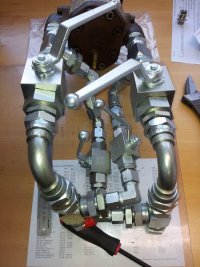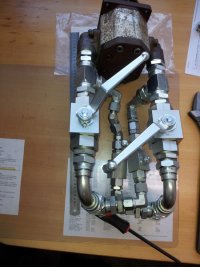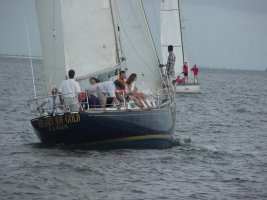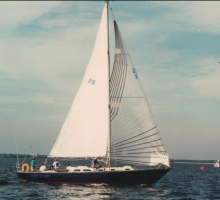-
Untitled Document Join us on March 28th, 7pm EDT
for the CBEC Virtual Meeting
EY.o March Zoom Meeting
All EYO members and followers are welcome to join the fun and get to know the people you've met online!
See the link below for login credentials and join us!
(dismiss this notice by hitting 'X', upper right)
You are using an out of date browser. It may not display this or other websites correctly.
You should upgrade or use an alternative browser.
You should upgrade or use an alternative browser.
sveinutne
Member III
I did not have time for the workshop to machine the parts I need, so I put in off the shelf parts so I can use the boat right away.
The problem (one of the many problems) will be that I will need an extra person to help me change direction. Later I will try to improve it, so I have full control from the cockpit.
Got the last parts today and I was able to make all parts fit. That was a good sign, now I just need to put it in the boat and see if there is room for all this. After my latest measurements there should be 1 cm of clearance in the length.


The problem (one of the many problems) will be that I will need an extra person to help me change direction. Later I will try to improve it, so I have full control from the cockpit.
Got the last parts today and I was able to make all parts fit. That was a good sign, now I just need to put it in the boat and see if there is room for all this. After my latest measurements there should be 1 cm of clearance in the length.


Now this monster of valves and tubings are fitted inside the boat. Tomorrow I will fill in the hydraulic fluid and see if it will work as intended.
So, do both handles have to be turned to achieve Forward, Neutral, and Reverse?
I could imagine a cable(or 2?) actuating a couple of bell-cranks, but the geometry is giving me a head ache.
:nerd:
Also, with hydraulic drive, I don't see where an engine would need a gear-box. The hydraulic motor does all the work, including having a neutral where no pressure is supplied to the driven motor.
Loren
Last edited:
sveinutne
Member III
The idea was to use a special handle that switched the hydraulic flow from forward to reverse, but then I needed to custom make some couplings. It needs some drawings and the workshop will need some time to machine it and this is a very slow process. With this of the shelf parts I can use the boat right away, but I will need a helping hand to get out of the harbor, because now I have to use 4 - four valves to control the flow.
With the two large valves open and the two small valves closed the boat will go forward. With the two large valves closed and the two small valves open the boat will go in reverse. With the two vales on the stern side closed and the other to open the boat will be in neutral. Not very practical if you want to sail by yourself, but this is and emergency solution so I can get out on the water while the custom made parts and made.
With the two large valves open and the two small valves closed the boat will go forward. With the two large valves closed and the two small valves open the boat will go in reverse. With the two vales on the stern side closed and the other to open the boat will be in neutral. Not very practical if you want to sail by yourself, but this is and emergency solution so I can get out on the water while the custom made parts and made.
Last edited:
The idea was to use a special handle that switched the hydraulic flow from forward to reverse, but then I needed to custom make some couplings. It needs some drawings and the workshop will need some time to machine it and this is a very slow process. With this of the shelf parts I can use the boat right away, but I will need a helping hand to get out of the harbor, because now I have to use 4 - four valves to control the flow.
With the two large valves open and the two small valves closed the boat will go forward. With the two large valves closed and the two small valves open the boat will go in reverse. With the two vales on the stern side closed and the other to open the boat will be in neutral. Not very practical if you want to sail by yourself, but this is and emergency solution so I can get out on the water while the custom made parts and made.
I am probably missing something in the details, but based on my experience with operating our club's dredge for a decade, our hydraulic controls are all single-handle for each motor function. (This is a small 6" suction dredge that pulls the slurry up from the bottom after it is stirred up with a rotating cutter head mounted in front of the suction pipe intake.)
That cutter head rotation is driven by a large hydraulic motor that I control with a single lever: three positions: forward for rotation one direction, neutral in the center position, and pulled back for reversal of rotation. Total throw is about 3" in either direction. There is a noticeable feel to each position, i.e. a detent that can be felt.
Effort to manipulate the handle is not that much, and it could easily be done by a remote push-pull cable in an application like yours.
This is common off-the-shelf hydraulic stuff, by the way. Nothing exotic at all.
FWIW, our hydraulics are powered by a 150 hp diesel engine.
I should also note that hydraulics are powerful, and all of our motors have relief valving that stops/relieves the pressure at about 1500 psi. This in case of running into an obstruction on the bottom and jamming the cutter head.
(Done that.....)
Loren
Last edited:
sveinutne
Member III
Loren,
You are right, and I was planning to use such a single-handle, and control it by the same wire I used to control the gearbox. In some of the pictures you can see this on my desk. The problem was that I needed to make the connection plate where four hydraulic pipes were connected to this control. If I choose to use flexible cables, the plate can be made without detailed adjustments, but if I should make it with only hard connections, fine measurements are needed. What I got now is only a solution, so I can get the boat out while waiting for the final solution. Also most of this single-handle units got internal holes that are less than ½ “, and for back and forth movement in the harbor that is fine, but for long distance drive, I want 1” pipes without too much frictions. So the plan is to have a combination of easy handling and good power. In the harbor I only use a small part of the power, so there the ½ “ pipes will be OK, and for most of my use this will be OK, but when I want to use the engine for longer periods, I plan to have the option to open the two large valves manually and get better performance. Also I hope the noise level will go down without the gearbox and the connection to the gearbox.
You are right, and I was planning to use such a single-handle, and control it by the same wire I used to control the gearbox. In some of the pictures you can see this on my desk. The problem was that I needed to make the connection plate where four hydraulic pipes were connected to this control. If I choose to use flexible cables, the plate can be made without detailed adjustments, but if I should make it with only hard connections, fine measurements are needed. What I got now is only a solution, so I can get the boat out while waiting for the final solution. Also most of this single-handle units got internal holes that are less than ½ “, and for back and forth movement in the harbor that is fine, but for long distance drive, I want 1” pipes without too much frictions. So the plan is to have a combination of easy handling and good power. In the harbor I only use a small part of the power, so there the ½ “ pipes will be OK, and for most of my use this will be OK, but when I want to use the engine for longer periods, I plan to have the option to open the two large valves manually and get better performance. Also I hope the noise level will go down without the gearbox and the connection to the gearbox.
sveinutne
Member III
Did some test run in the dock, and it looks to work OK. When I get time and the temperature will go above 10 degrees I will take it out on the fjord for the first time this year. Then I will see what the cruse speed will be on idle, and also how the speed will be at 500, 1000 and 1500 rpm. I do not think I will go any higher than that on the first test run.
sveinutne
Member III
We had nice weather this weekend, so I had a change to test the boat on the fjord. I needed a helping hand to change direction, but that was only on the first test on Saturday. On Sunday I went out two times by myself and it is possible in nice weather, but with some wind or strong current I will need one extra person to help with switching direction on the propeller. The rpm on the engine and the noise has been reduced a lot. Now we can sit in the cockpit and have a quiet chat while the boat is cruising at 5 knots. At 1200 rpm the engine is running very nice and the boat is making good speed. I will bring my ipad and try to calibrate the speed at 1200 rpm, but I will guess it is around 4-5 knots. I still got some hydraulic leaks when I push it above 1200 rpm, so I need to work on that before going any higher, but just being able to get back out on the fjord again is fantastic.
We had nice weather this weekend, so I had a change to test the boat on the fjord. I needed a helping hand to change direction, but that was only on the first test on Saturday. On Sunday I went out two times by myself and it is possible in nice weather, but with some wind or strong current I will need one extra person to help with switching direction on the propeller. The rpm on the engine and the noise has been reduced a lot. Now we can sit in the cockpit and have a quiet chat while the boat is cruising at 5 knots. At 1200 rpm the engine is running very nice and the boat is making good speed. I will bring my ipad and try to calibrate the speed at 1200 rpm, but I will guess it is around 4-5 knots. I still got some hydraulic leaks when I push it above 1200 rpm, so I need to work on that before going any higher, but just being able to get back out on the fjord again is fantastic.
Good for You! Nothing like getting your boat away from the dock for a while to help you remember why you started the whole darned project in the first place!
Cheers,
Loren
sveinutne
Member III
Did a short run with the iPad yesterday, and at 1200 rpm the speed was 4.9 knots and the engine was running very light. When I increased the rpm till 1600 the speed cam close to 6 knots, but I aborted the test before the speed was stable because the leaks from the hydraulic system. I got some problems because of lack of space to tighten all the connections properly, but I will make a custom tool that will do the job, so it will be OK in the end. So then the question will be what the speed can be after all the couplings are tightened? Will it be 7 knots at 2000 rpm? What will it be at 3000 rpm if I still can get the engine up to that speed?
Also how the fuel consumption will change with rpm. I feel 1200 till 1600 rpm is what it should be during cruse speed. This gives good speed at low noise and hopefully low fuel consumption.
Also how the fuel consumption will change with rpm. I feel 1200 till 1600 rpm is what it should be during cruse speed. This gives good speed at low noise and hopefully low fuel consumption.
What's New?
It's been a while and I am curious to know how this project is coming along.
Sailing and doing some cruising I hope!
Loren
It's been a while and I am curious to know how this project is coming along.
Sailing and doing some cruising I hope!
Loren
sveinutne
Member III
It's been a while and I am curious to know how this project is coming along.
Sailing and doing some cruising I hope!
Loren
Loren beach,
Nice of you to ask. I am doing well and the boat has sailed many short trips, but I have only spent a handful nights in the boat, because the temperature in Norway is so low, it is not so nice to spend the night in a cold boat, so now I am installing a Webasto 5.5 kw water heater. It is a new world with this heater. I have the Webasto all the way in the back, and some tubing with hot water running through three radiators that is heating up the saloon and the front cabin.
The boat is now resting on land, but in May I hope everything will be ready, and the boat will be ready for longer trips.
Regards
Svein Utne
Updates?
It's been several years. Are you sailing and doing some cruising on the boat now?
Some pictures would be nice!

It's been several years. Are you sailing and doing some cruising on the boat now?
Some pictures would be nice!
sveinutne
Member III
Sorry for slow answer
The boat is on water, but the sailing season is soon over for this summer. I hope to improve the boat during the winter, so it will be ready for longer cruises. My dream is to sail it down to Tenerife in 2021, and spend the winter there before sailing to Greece in 2022. The Webasto heater is nice.
What will be a dream and what will be reality is for the future to tell.
Regards
Svein
It's been several years. Are you sailing and doing some cruising on the boat now?
Some pictures would be nice!

The boat is on water, but the sailing season is soon over for this summer. I hope to improve the boat during the winter, so it will be ready for longer cruises. My dream is to sail it down to Tenerife in 2021, and spend the winter there before sailing to Greece in 2022. The Webasto heater is nice.
What will be a dream and what will be reality is for the future to tell.
Regards
Svein
Any updates to this modern Viking 'saga' ?


Just moving the thread to the top again -- out of curiosity .... !


![20140410_133342[1].jpg 20140410_133342[1].jpg](https://ericsonyachts.org/ie/data/attachments/10/10142-476dbc879c74dbd13dd185b65ab35c41.jpg)

